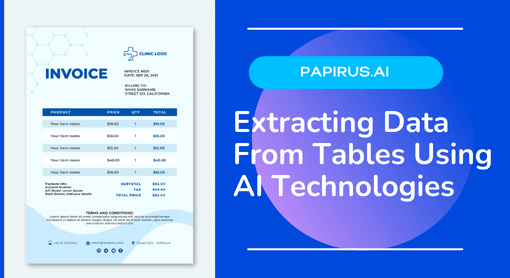
Extracting Data From Tables Using AI Technologies and Table OCR
Working with tables and complex documents can quickly become overwhelming, especially when you’re looking to extract data from them. Fortunately, Artificial Intelligence (AI) technologies are making it easier than ever before to extract line items from these documents. In this article, we’ll look at how AI technologies can help you about table ocr in complex documents.
Introduction to AI Technologies for Data Extraction
Most of us have been in a situation where we needed to extract data from a table, but the process was so tedious and time-consuming that we wished there was an easier way. Luckily, there are now AI technologies that can help with table ocr! In this blog post, we’ll introduce you to some of these technologies and show you how they can be used to easily extract line items from complex documents.
Some of the most popular AI technologies for data extraction include optical character recognition (OCR), natural language processing (NLP), and machine learning (ML). OCR is used to convert scanned images of text into editable text files. NLP can be used to analyze unstructured text data and extract information from it. ML can be used to learn patterns from data and make predictions about new data.
These technologies can be used together or separately, depending on the needs of the specific application. For example, OCR can be used to extract data from a table that is contained in an image file. NLP can then be used to analyze the extracted data and identify relationships between different entities. ML can be used to learn additional patterns from the extracted data and make predictions about new data that is similar to the original dataset.
No matter which AI technology or combination of technologies you use for data extraction, the goal is always the same: to make the process of extracting information from complex documents as easy and efficient as possible!
What is Line Item Extraction and Table OCR?
Line item extraction is a process of extracting specific information from a document. This can be done manually or with the help of technology. With the help of technology, line item extraction can be done automatically with the help of software that can identify and do table ocr.
Manual line item extraction is a time-consuming process and is prone to errors. Automated line item extraction using AI technologies is a more efficient and accurate method to extract data from tables. It can identify the relevant information in a document and extract it quickly and accurately.
Benefits of Using Artificial Intelligence and Machine Learning
Artificial intelligence and machine learning can be used to Extract Data From Tables much more easily than traditional methods. Here are some benefits of using these technologies:
- Increased accuracy – By using artificial intelligence and machine learning algorithms, we can achieve much higher accuracy rates for table ocr.
- Greater speed – AI and ML can help us process data much faster, meaning we can get the information we need in a shorter amount of time.
- Reduced costs – Automating the process of data extraction using AI and ML can help reduce the overall cost of the project.
Common Challenges Faced During Table OCR
One of the most common challenges faced when extracting line items from complex documents is the lack of standardization. This can make it difficult to identify and extract the desired information from a document, as there may be numerous different formats and styles that need to be accounted for.
Another challenge that often arises is the presence of errors or inaccuracies in the document itself. This can make it difficult to accurately extract the data, as even a small mistake can lead to incorrect or incomplete results.
Finally, many documents may also be protected by security features such as passwords or encryption, which can prevent the data from being extracted even if all other challenges are overcome.
Strategies For Automating Data Extraction
There are a number of different strategies that can be employed when automating data extraction from tables. The most effective strategy will vary depending on the specific table structure and the desired output. However, there are a few general tips that will always be useful:
- When possible, use optical character recognition (OCR) to automatically read the contents of the table. Table OCR can be a very effective way to extract data from simple tables with well-defined boundaries.
- If OCR is not an option, or if the table is more complex, consider using a template-based approach. This involves manually creating a template of the desired output and then using it to guide the extraction process.
- Another option for complex tables is to use a rule-based approach, where extraction rules are defined and then applied to the data. This can be an effective way to deal with highly variable table structures.
- Finally, some tables may be suitable for machine learning techniques. This involves training a computer to recognize patterns in the data and then use those patterns to extract the desired information.
Conclusion
Using AI technologies to extract data from tables and documents can be invaluable for businesses that need to quickly process complex files. By leveraging the power of machine learning, organizations can save time and money by automating their document processing needs. With a little bit of preparation, organizations can easily set up an automated system that extracts line items from their documents in an accurate and efficient manner. So if you are looking to improve your data extraction processes, why not give AI Technologies a try?
For your all document capture needs contact us. Papirus AI will increase your efficiency.